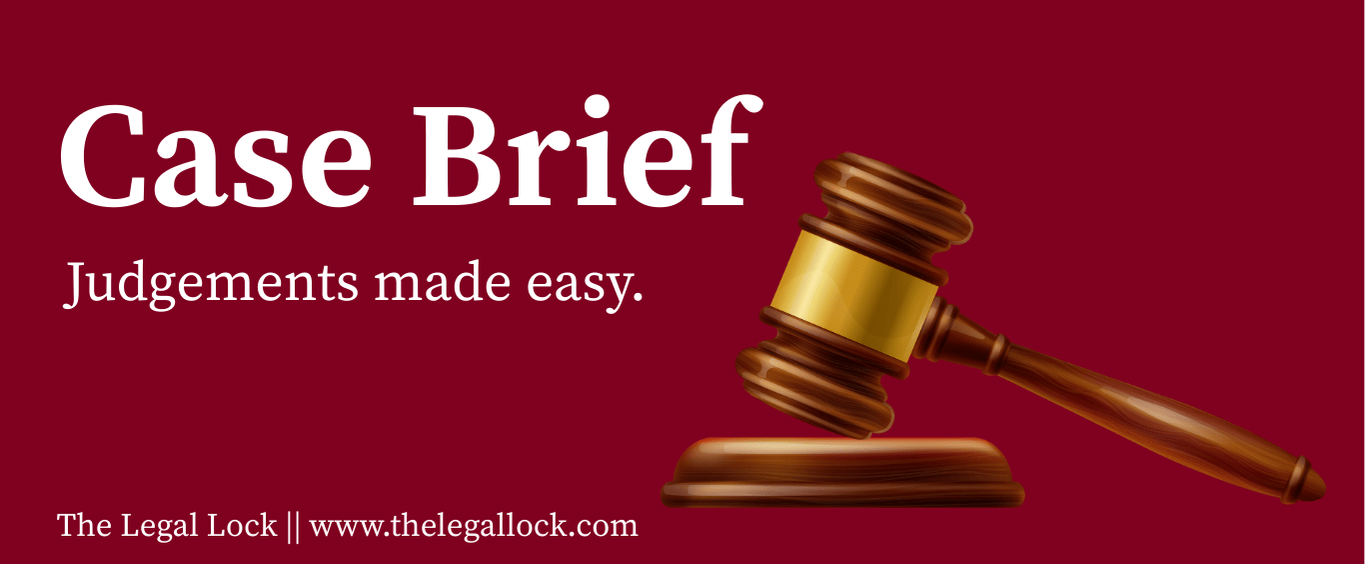Case Brief: Rohan Dhungat vs State of Goa and Ors

| Case Name | Rohan Dhungat vs State of Goa and Ors |
| Citation | SPECIAL LEAVE PETITION (CRL) NOS. 12574-12577 OF 2022 (@ DIARY NO. 29535 OF 2022) |
| Court | The Supreme Court of India |
| Bench | M.R. Shah, C.T. Ravikumar |
| Appellant | Rohan Dhungat |
| Respondent | State of Goa |
| Judgment On | January 5, 2023 |
Introduction
The term of parole is to be excluded for the purpose of considering actual imprisonment. If the prisoners’ submission, which asks that the period of parole be included while considering 14 years of actual imprisonment, is accepted, any influential prisoner may be granted parole on an unlimited basis without any restrictions. If the prisoners’ submission is accepted, it may also defeat the very goal of actual imprisonment.
The case of Rohan Dhungat Vs. State of Goa involves a legal dispute regarding the inclusion of the period of parole in the calculation of actual imprisonment for the purpose of premature release for convicts serving life imprisonment. The convicts were released on parole under the Goa Prisons Rules, 2006, and subsequently applied for premature release, which was recommended by the State Sentence Revenue Board but rejected by the State Government based on the gravity of the offense. The convicts challenged this decision, arguing that the period of parole should be included in the calculation of their 14 years of actual imprisonment. The High Court of Bombay at Goa dismissed the writ petitions, holding that the period of parole is to be excluded from the period of sentence under the Rules, 2006 while considering 14 years of actual imprisonment for the purpose of premature release. The Supreme Court upheld the High Court’s decision, ruling that the period of parole is to be excluded from the calculation of actual imprisonment for the purpose of premature release. This judgment sets a precedent by clarifying the treatment of parole in the context of calculating actual imprisonment for premature release, emphasizing the remissive nature of parole and its exclusion from the period of sentence
Facts of the case
The case’s factual foundation states that each Petitioner was given a life sentence and was granted release in compliance with the Goa Prisons Rules, 2006 (also known as the “Rules, 2006”). Furthermore, in accordance with the Rules of 2006, every Petitioner asked for an early release. The State Sentence Revenue Board advocated against premature release. Regarding the petitioners’ early release, the State Government asked the convicting court to rule.
Because of the seriousness of the offense, the convicting court determined that the guilty should not be freed immediately. As a result, the State Government denied the Petitioners’ early release. The Petitioners challenged the State’s judgment in a writ action before the Bombay High Court, where it was determined to exclude the parole period from the sentence, even though it included 14 years of actual incarceration for the premature release.
Issues Raised
- It was contended that the High Court erred significantly in concluding that the period of parole is to be removed from the period of sentence under the Rules, 2006 while accounting for 14 years of actual incarceration for premature release.
- The main point presented for this Court’s consideration is whether, in order to achieve premature release, the 14 years of actual incarceration should be taken into account and the parole period subtracted from the sentence under the Rules of 2006.
Arguments from Both sides
Senior Counsel for the petitioners, Shri Dave, is adamant that the Hon’ble High Court erred in reading Rule 335 of the Rules, 2006 to infer that a parole period cannot be included in the computation of a sentence since it is deemed remission.
The argument states that criminal defendants may be deemed to be in custody or judicial custody even when they are on parole, hence the length of parole must be considered when determining the 14 years of actual incarceration for the purpose of premature release.
The stance of the High Court is strongly maintained to be at odds with the decisions made by this Court in the cases of Sunil Fulchand Shah v. Union of India (reported in (2000) 3 SCC 409 and Avtar Singh v. State of Haryana (para. 11)).
Senior attorney Shri Dave further contends that even under Section 55 of the Prisons Act of 1894, a prisoner is regarded to be in custody when being transferred to or from any prison in which he may be legitimately confined. The original writ petitioners are convicts. Therefore, while determining the real length of imprisonment after 14 years of incarceration, the parole period must be considered.
It is hoped that the court will decide that the length of parole should be considered when deciding whether to grant an early release following a 14-year prison sentence in light of the aforementioned grounds. When considering the aforementioned topic or issue, it is imperative to consider the purpose and intent of conditional parole. Parole is a conditional release. Parole could be granted in the case of a short jail sentence. Parole has been extended to a month in length. Parole is granted by the State government. Parole requires a particular reason. It is feasible to be granted parole more than once.
In view of the previously indicated facts, the question in this case—namely, whether the parole period is to be excluded from the length of the sentence while assessing 14 years of actual incarceration for the purpose of premature release—should be given careful consideration.
Rule 335 of the Rules, 2006, which specifies that the length of release on furlough and parole shall be counted as remission of sentence, was widely cited or considered by the High Court. Upon issuance of the disputed judgment and order, the court ruled that the parole time should not be included in the sentence, accounting for the full 14 years of incarceration. When considering the 14 years of real imprisonment, the parole period must also be subtracted from the total punishment period if it is to be regarded as a reduction in sentence, as the High Court properly recognized and decided.
Currently, the aforementioned precedent will not apply to the facts of the case at hand, despite the senior counsel for the numerous petitioners—convicts and prisoners—relying on the court’s ruling in the Sunil Fulchand Shah case. In accordance with the COFEPOSA Act, it was a detenue case. Even in the previously mentioned ruling, it is observed and concluded that unless the parole order, regulations, or instructions expressly specify otherwise as a term and condition of parole, the detainee’s period of release will not automatically lengthen their time behind bars. In this instance, the term “imprisonment” is not included in determining the length of parole. As per Rule 335, parole is equivalent to a sentence remission.
Therefore, the facts of the current case would preclude the applicability of the previously cited ruling. The ruling in the case of Avtar Singh will also not apply to the facts of this case when deciding whether the release period should be deducted from the total sentence under the Rules, 2006 when estimating 14 years of actual incarceration.
Regarding the petitioners’ claim that, according to Section 55 of the Prisons Act of 1894, prisoners are still considered to be in custody when they are on parole and that this period should be applied to their actual incarceration, that claim is without validity. Section 55 of the Prisons Act of 1894 shall not apply with respect to parole release. A prisoner is considered to have been incarcerated under Section 55 of the Prisons Act of 1894 if he is released from custody. That being said, parole release will not be affected by the same. All of these Special Leave Petitions are hereby properly dismissed for the reasons stated above, in light of the aforementioned and previous reasoning.
Judgment
The bench consisting of Honorable Mr. Justice M.R. Shah and Honorable Mrs. Justice B.V. Nagarathna rendered the decision in the Rohan Dhungat v. State of Goa case. Pending applications were resolved, and the appeal was denied. The Bombay High Court in Goa dismissed the writ petitions, ruling that the parole period should not be included in the sentence and that 14 years of real imprisonment should be taken into account in order to allow for an early release. The original writ petitioners, who were convicts undergoing life imprisonment, had challenged the State’s decision not to consider their case for premature release. They argued that the period of parole should be included in the calculation of actual imprisonment, but the High Court disagreed, citing Rule 335 of the Rules, 2006, which provides that the period of release on parole “shall be counted as remission of sentence.”
The Supreme Court upheld the High Court’s decision, ruling that the period of parole is to be excluded from the calculation of actual imprisonment for the purpose of premature release. The Court emphasized that including the period of parole in the calculation of actual imprisonment would undermine the purpose of imprisonment and could lead to influential prisoners obtaining multiple parole periods, defeating the purpose of actual imprisonment. The judgment sets a precedent by clarifying the treatment of parole in the context of calculating actual imprisonment for premature release, emphasizing the remissive nature of parole and its exclusion from the period of sentence. Therefore, the appeals were dismissed.
Conclusion
The conclusion of the case of Rohan Dhungat Vs. State of Goa is that the Supreme Court upheld the decision of the High Court, ruling that the period of parole is to be excluded from the calculation of actual imprisonment for the purpose of premature release. The Court emphasized that including the period of parole in the calculation of actual imprisonment would undermine the purpose of imprisonment and could lead to influential prisoners obtaining multiple parole periods, defeating the purpose of actual imprisonment. The judgment sets a precedent by clarifying the treatment of parole in the context of calculating actual imprisonment for premature release, emphasizing the remissive nature of parole and its exclusion from the period of sentence. Therefore, the appeals were dismissed. This judgment provides clarity on the treatment of parole in the context of premature release for convicts serving life imprisonment.






